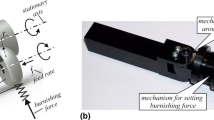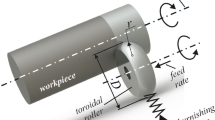Abstract
This article presents the outcomes of finite element (FE) simulations and X-ray stress measurements of residual stresses in high-strength 2024-T3 Al alloy introduced via the single toroidal roller burnishing (STRB) process. In terms of the deforming toroidal roller geometry, STRB is particularly suitable for deep rolling. A 3D FE model was developed using the flow stress concept, and the actual STRB kinematics was simulated to evaluate both hoop and axial residual stresses. The FE model was validated through a comparison of FE and X-ray residual stress distributions. The effects of the burnishing force, feed rate, and number of passes on the residual hoop and axial stresses were studied. It was established that increasing the feed rate leads to a decrease in the residual hoop stresses and an increase in the residual axial stresses. The greater burnishing force increases the compressive zone depth and only slightly increases the surface residual stresses. The FE and X-ray stress analyses confirm the effectiveness of STRB of 2024-T3 Al alloy to introduce significant residual compressive axial and hoop stresses.








Similar content being viewed by others
Abbreviations
- A 5 :
-
Elongation
- A :
-
Amplitude
- B :
-
Amplitude
- C :
-
Kinematic hardening modulus
- D :
-
External diameter of the toroidal deforming roller
- d :
-
Workpiece diameter
- \(d_{\text{p}}\) :
-
Depth of penetration
- E :
-
Young’s modulus
- f :
-
Feed rate
- \(F_{\text{b}}\) :
-
Burnishing force
- n :
-
Number of passes
- N :
-
Number of cycles to failure
- r :
-
Radius of the toroid of the toroidal deforming roller
- R :
-
Cycle asymmetry coefficient
- \(t_{\text{step}}\) :
-
One cycle time
- \(v\) :
-
Burnishing velocity
- \(\alpha_{ij}\) :
-
Back-stress tensor
- \(\bar{\varepsilon }_{\text{p}}\) :
-
Equivalent plastic strain
- \(\phi\) :
-
Roller rotation angle
- \(\gamma\) :
-
Rate of decrease in C
- \(\nu\) :
-
Poisson’s ratio
- \(\theta (\theta_{0} )\) :
-
Central angles of the workpiece modeled portion
- \(\sigma^{0}\) :
-
Equivalent stress
- \(\sigma_{\text{a}}\) :
-
Stress amplitude
- \(\sigma_{ij}\) :
-
Stress tensor
- \(\sigma_{ - 1}\) :
-
Fatigue limit for symmetrical cycle
- \(\sigma_{\text{u}}\) :
-
Ultimate stress
- \(\sigma_{\text{Y}}\) :
-
Yield limit
- \(\sigma_{\text{t}}^{\text{res}}\) :
-
Residual hoop stress
- \(\sigma_{\text{z}}^{\text{res}}\) :
-
Residual axial stress
- \(\omega\) :
-
Angular velocity
- \(\psi\) :
-
Transverse contraction
- CNC:
-
Computer numerical control
- DR:
-
Deep rolling
- FE:
-
Finite element
- HBB:
-
Hydrostatic ball burnishing
- LPB:
-
Low plasticity burnishing
- MST:
-
Mechanical surface treatment
- RB:
-
Roller burnishing
- SB:
-
Slide burnishing
- SRB:
-
Single roller burnishing
- STRB:
-
Single toroidal roller burnishing
References
Maximov JT, Duncheva GV, Anchev AP, Ichkova MD (2019) Slide burnishing—review and prospects. Int J Adv Manuf Technol 104:785–801
Catalogue E (2006) Tools and solutions for metal surface improvement. Ecoroll Corporation Tool Technology USA
Maximov JT, Anchev AP, Dunchev VP, Ganev N, Duncheva GV, Selimov KF (2017) Effect of slide burnishing basic parametrers on fatigue performance of 2024-T3 high-strength aluminium alloy. Fatigue Fract Eng Mater Struct 40(11):1893–1904
Maximov JT, Anchev AP, Duncheva GV, Ganev N, Selimov KF, Dunchev VP (2019) Impact of slide diamond burnishing additional parameters on fatigue behaviour of 2024-T3 Al alloy. Fatigue Fract Eng Mater Struct 42(1):363–373
Borkar AP, Kamble PS, Seemikeri CY (2014) Surface integrity enhancement of inconel 718 by using roller burnishing process. Int J Curr Eng Technol 4(4):2595–2598
Hassani-Gangaraj S, Carboni M, Gnagliano M (2015) Finite element approach toward an advanced understanding of deep rolling induced residual stresses, and an application to railway axles. Mater Des 83:689–703
Dwivedi SP, Sharma S, Mishra RK (2014) Effects of roller burnishing process parameters on surface roughness of A356/5%SiC composite using response surface methodology. Adv Manuf 2:303–317
Perenda J, Trajkovski J, Zerovnik A, Prebil I (2015) Residual stresses after deep rolling of a torsion bar made from high strength steel. J Mater Process Technol 218:89–98
Abrão AM, Denkena B, Köhler J, Breidenstein B, Mörke T (2014) The influence of deep rolling on the surface integrity of AISI 1060 high carbon steel. Proc CIRP 13:31–36
Chomienne V, Valiorgue F, Rech J, Verdu C (2016) Influence of ball burnishing on residual stress profile of a 15-5PH stainless steel. CIRP J Manuf Sci Technol 13:90–96
Yuan X, Sun Y, Li C, Liu W (2017) Experimental investigation into the effect of low plasticity burnishing parameters on the surface integrity of TA2. Int J Adv Manuf Technol 88:1089–1099
Zhang P, Lindemann J, Ding WJ, Leyens C (2010) Effect of roller burnishing on fatigue properties of the hot-rolled Mg–12Gd–3Y magnesium alloy. Mater Chem Phys 124:835–840
Fouad Y, Mhaede M, Wagner L (2010) Effect of mechanical surface treatment on fatigue performance of extruded ZK60 alloy. Fatigue Fract Eng Mater Struct 34:403–407
Wagner L, Mhaede M, Wollmann M, Altenberger I, Sano Y (2011) Surface layer properties and fatigue behavior in Al 7075-T73 and Ti–6Al–4V. Comparing results after laser peening, shot peening and ball-burnishing. Int J Struct Integr 2(2):185–199
Yen YC, Sartkulvanich P, Altan T (2005) Finite element modeling of roller burnishing process. CIRP Ann Manuf Technol 54(1):237–240
Sartkulvanich P, Altan T, Jasso F, Rodriguez C (2007) Finite element modeling of hard roller burnishing: an analysis on the effects of process parameters upon surface finish and residual stresses. J Manuf Sci Eng 129(4):705–716
Maximov JT, Anchev AP, Duncheva GV, Ganev N, Selimov KF (2017) Influence of the process parameters on the surface roughness, micro-hardness, and residual stresses in slide burnishing of high-strength aluminum alloys. J Braz Soc Mech Sci Eng 39(8):3067–3078
Maximov JT, Duncheva GV, Anchev AP, Ganev N, Amudjev IM, Dunchev VP (2018) Effect of slide burnishing method on the surface integrity of AISI 316Ti chromium–nickel steel. J Braz Soc Mech Sci Eng 40:194. https://doi.org/10.1007/s40430-018-1135-3
Maximov JT, Duncheva GV, Anchev AP, Ganev N, Dunchev VP (2019) Effect of cyclic hardening on fatigue performance of slide burnished components made of low-alloy medium carbon steel. Fatigue Fract Eng Mater Struct 42(6):1414–1425
Maximov JT, Duncheva GV, Anchev AP (2019) A temperature-dependent, non-linear kinematic/isotropic hardening material constitutive model of the surface layer of 37Cr4 steel subjected to slide burnishing. Arab J Sci Eng 44(6):5851–5862
Bougharriou A, Saï WB, Saï K (2010) Prediction of surface characteristics obtained by burnishing. Int J Adv Manuf Technol 51:205–215
Salahshoor M, Guo YB (2011) Finite element modeling of burnishing and the effects of process parameters on surface integrity of orthopedic implants. In: Proceedings of the ASME 2011 international mechanical engineering congress and exposition IMECE2011, November 11–17, Denver, Colorado, USA
Sayahi M, Sghaier S, Belhadjsalah H (2013) Finite element analysis of ball burnishing process: comparisons between numerical results and experiments. Int J Adv Manuf Technol 67:5–8
Hassanifard S, Mousavi M, Varvani-Farahani A (2018) The influence of low-plasticity burnishing process on the fatigue life of friction-stir-processed Al7075-T6 samples. Fatigue Fract Eng Mater Struct 42(3):764–772
Mohammadi F, Sedaghati R, Bonakdar A (2014) Finite element analysis and design optimization of low plasticity burnishing process. Int J Adv Manuf Technol 70:1337–1354
Zhuang W, Wicks B (2004) Multipass low-plasticity burnishing induced residual stresses: three-dimensional elastic–plastic finite element modeling. Proc Inst Mech Eng Part C J Mech Eng Sci 218(6):663–668
Aldrine ME, Mahendra Babu NC, Anil Kumara S (2017) Evaluation of induced residual stresses due to low plasticity burnishing through finite element simulation. Mater Today Proc 4:10850–10857
Balland P, Tabourot L, Degre F, Moreau V (2013) An investigation of the mechanics of roller burnishing through finite element simulation and experiments. Int J Mach Tool Manuf 65:29–36
Beghini M, Bertini L, Monelli BD, Santus S, Bandini M (2014) Experimental parameter sensitivity analysis of residual stresses induced by deep rolling on 7075-T6 aluminium alloy. Surf Coat Technol 254:175–186
Duncheva GV, Atanasov TP (2020) Finite element modeling and optimization of the deep rolling process with a torodal roller in aluminum alloy 2024 T3. J Tech Univ Gabrovo 60:3–14
Maximov JT, Duncheva GV, Anchev AP, Ichkova MD (2014) Modeling of strain hardening and creep behaviour of 2024-T3 aluminium alloy at room and high temperatures. Comput Mater Sci 83:381–393
Ganev N, Frydrýšek K, Kolařík K (2007) Possibilities of FEM for verification of X-ray measurement of residual stresses depth distribution. In: Book of extended abstracts. 9th international scientific conference applied mechanics 2007. Technical University of Ostrava, Malenovice, April 16–19, 2007, pp 85–86, ISBN 978-80-248-1389-9
Acknowledgements
This work was supported by the European Regional Development Fund within the OP “Science and Education for Smart Growth 2014–2020”, Project CoC “Smart Mechatronics, Eco- and Energy Saving Systems and Technologies”, No. BG05M2OP001-1.002-0023.
Author information
Authors and Affiliations
Corresponding author
Additional information
Technical Editor: Lincoln Cardoso Brandao.
Publisher's Note
Springer Nature remains neutral with regard to jurisdictional claims in published maps and institutional affiliations.
Rights and permissions
About this article
Cite this article
Duncheva, G.V., Maximov, J.T., Anchev, A.P. et al. Finite element and experimental study of the residual stresses in 2024-T3 Al alloy treated via single toroidal roller burnishing. J Braz. Soc. Mech. Sci. Eng. 43, 55 (2021). https://doi.org/10.1007/s40430-020-02775-8
Received:
Accepted:
Published:
DOI: https://doi.org/10.1007/s40430-020-02775-8




